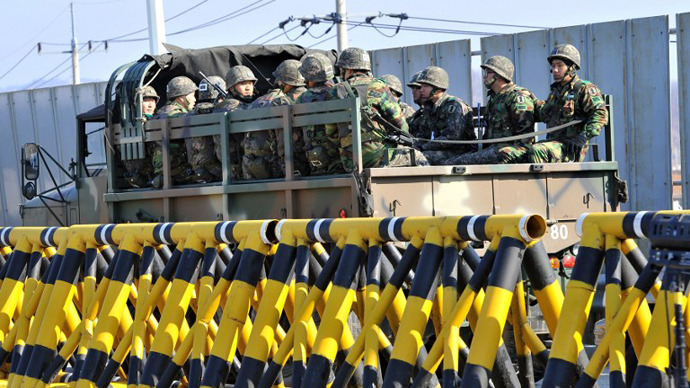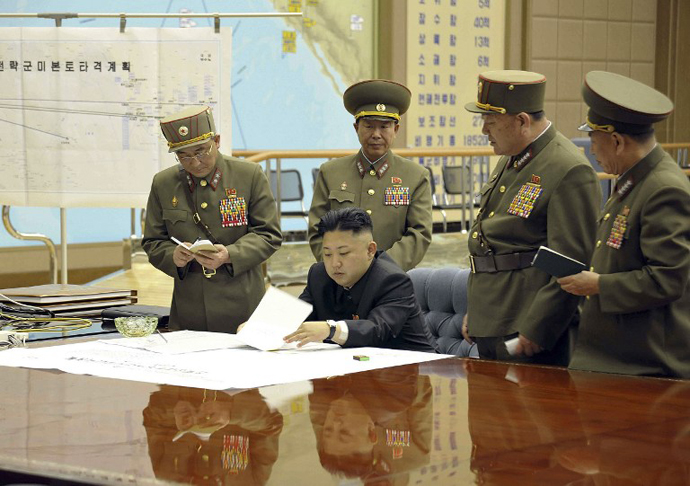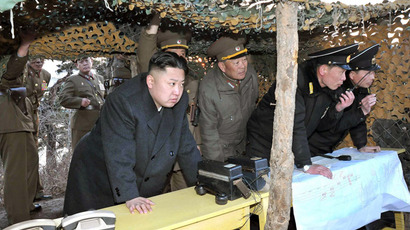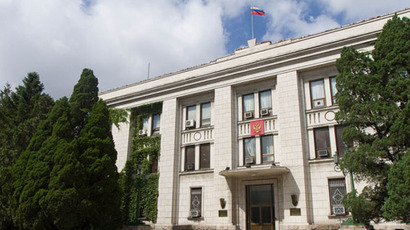US, S. Korea on high alert in anticipation of Pyongyang’s missile launch

The United States and South Korea have upgraded their military surveillance status in anticipation of a possible mid-range missile launch by Pyongyang, the latest escalation of tension in the war-weary peninsula.
The Combined Forces Command is effectively at Watchcon 2 status
ready to tackle a "vital threat" from North Korea; Yonhap
news agency reported citing an anonymous senior military official.
If the next upgrade occurs, the nations will be in a state of
war.
Seoul has also launched an emergency task force to analyze North
Korea's preparations of a missile launch, the official said.
“There are clear signs that the North could simultaneously fire
off Musudan, Scud and Nodong missiles.”
To counter this “vital threat”, two Aegis destroyers with
SPY-1 radar, have been placed on standby on the coasts of the
Korean Peninsula.
South Korean military is also operating early warning aircraft
Peace Eye and ground-based missile defense radar system Green Pine
to counter a potential rocket launch.
S. Korean and US intelligence believes that the North has completed
all the necessary arrangements for an east coast mid-range missile
launch after relocating two of the Musudan missiles last week and
mounting them on mobile launchers, possibly to correspond with
April 15 birthday celebrations of Kim Il-Sung.
These missiles have a 3,000-4,000 kilometer range, allowing them to
potentially hit the US forces in the Pacific Ocean.
Furthermore, Seoul believes that the North may fire off several
missiles from different sites, in case of an unsuccessful launch of
the Musudan missile, which has never been tested before, as up to
five TELs (transporter-erector-launcher) as seen in satellite
pictures.
The TELs are perceived to be launch platforms for short-range
(300-500 kilometers) Scud missiles and medium-range Nodong
missiles, capable of hitting targets 1,500 km away, the source
said.

On Tuesday, Admiral Samuel Locklear, commander of US Pacific
Command told the US Senate Armed Services Committee that US has the
capability and is ready to tackle any threat emanating from
Pyongyang.
“I believe we have the ability to defend the homeland, Guam,
Hawaii and defend our allies,” Locklear said, adding “We
have demonstrated to the people of the region, demonstrated to the
leadership of North Korea, our ability and willingness to defend
our nation, our people, our allies and our forward deployed
forces.”
Lockland concluded that the US could intercept a missile even if it
launched in the next several days.
"If the missile was in defense of the homeland, I would
certainly recommend that action (of intercepting it). And if it was
defense of our allies, I would recommend that action," Locklear
told a Senate hearing in Washington.
But as Pyongyang tells foreigners to evacuate S. Korea after
warning of ‘thermonuclear’ war, Japan, has authorized
shooting down any threat coming from Pyongyang, and announced on
Tuesday that it has deployed PAC-3 missile interceptors to key
locations around Tokyo.
Meanwhile China, one of the only sympathizers of North Korea has
closed its border with the North to tourists.
The Korean peninsula has seen tensions escalate since the
North's third nuclear test in February, which resulted in toughened
UN sanctions and drew much international condemnation.














